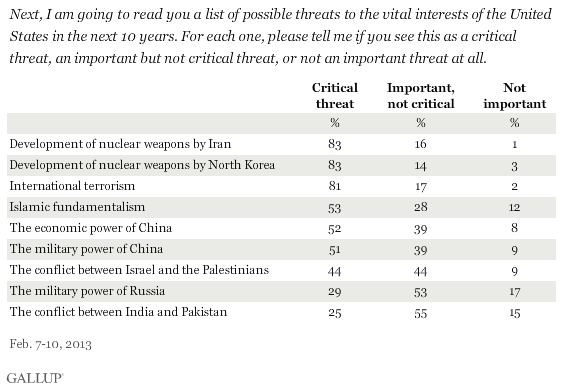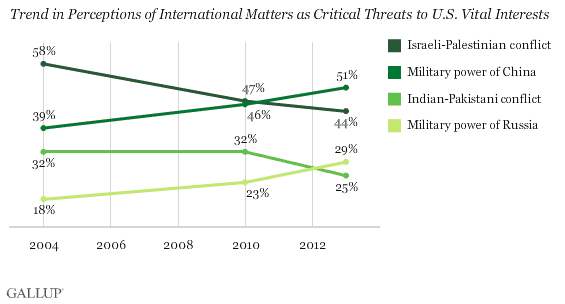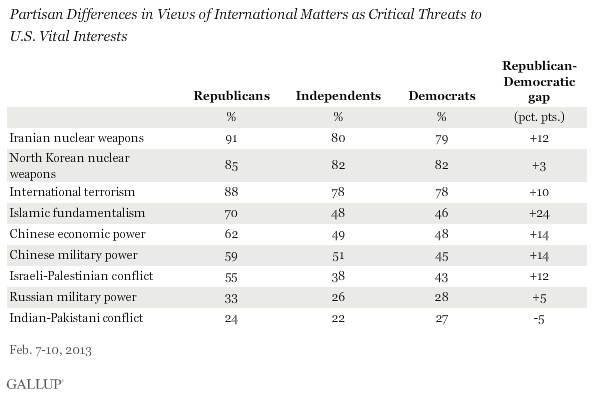PRINCETON, NJ -- Eighty-three percent of Americans say the development of nuclear weapons by North Korea is a critical threat to the vital interests of the United States, placing it at the top of a list of nine potential threats, along with Iranian nuclear weapons and international terrorism.

The Feb. 7-10 poll was conducted just before North Korea conducted its third nuclear test, so Americans already saw it as a serious threat before the latest news. North Korea's continued nuclear ambitions and defiance of international efforts to prevent it from developing nuclear weapons are likely a reason Americans' basic opinions of the country are among the most negative of any that Gallup measures. Americans also frequently mention North Korea as the United States' greatest enemy, though Iran has topped the list in recent years.
After North Korean and Iranian nuclear weapons and international terrorism, Americans are most likely to view Islamic fundamentalism and China's economic and military power as critical threats to U.S. vital interests. Less than half believe the Israeli-Palestinian conflict, the Indian-Pakistani conflict, and the military power of Russia pose similar threats to the United States.
This year's poll marked the first time Gallup asked about North Korean and Iranian nuclear weapons specifically. In 2010 Gallup asked about the two countries' "military power," and found 61% rating each as a critical threat to the United States, second only to international terrorism. In 2004, the "spread of weapons of mass destruction to unfriendly powers" ranked second only to terrorism. Thus, Americans have previously seen North Korea and Iran, and nuclear weapons in general, as serious threats to the U.S.
Americans Increasingly See China as a Threat
Americans' perceptions of the threat some of these international matters pose to the United States have shifted in recent years. Specifically, since 2004, Americans have increasingly viewed the military power of China and the military power of Russia as threats. Over the same period, Americans have come to view the Israeli-Palestinian and Indian-Pakistani conflicts as less threatening to the United States.

Eight in 10 Americans have consistently viewed international terrorism as a critical threat. It has ranked at the top of the list in the three times Gallup has asked a version of this question.
Democrats, Republicans Equally View North Korea as a Threat
Americans' assessments of North Korean nuclear ambitions as a critical threat to the United States vary little by subgroup, including by party identification. However, that is not the case for most of the other international matters, including Iran's development of nuclear weapons. Republicans are more likely than Democrats to say most of the matters are critical threats. The greatest party differences are in regard to Islamic fundamentalism, viewed as a threat by 70% of Republicans and 46% of Democrats.

There are also wide gaps by age in the percentages viewing Islamic fundamentalism and the Israeli-Palestinian conflict as critical threats, with older Americans more likely to say each is a threat.

Implications
Even before North Korea's nuclear test last week, Americans viewed the country's potential development of a nuclear weapon as a critical threat to U.S. vital interests. Thus, the test may serve mainly to reinforce what Americans were already thinking about North Korea rather than to change their opinions about it.
The high level of concern Americans give to North Korea, as well as to Iran and to international terrorism, suggest these are areas on which the public would like the Obama administration and its new foreign policy team to focus its efforts.
Gallup did not ask Americans what they might suggest the Obama administration do to address these issues. Of course, efforts to deter North Korea and Iran from developing nuclear weapons have largely been unsuccessful, and it is not clear whether the United States or the international community is seriously considering potentially provocative interventions such as military action against either country. Unless the possibilities of a nuclear Iran or North Korea subside, Americans are likely to view each country as threats to the United States.
Survey Methods
Results for this Gallup poll are based on telephone interviews conducted Feb. 7-10, 2013, with a random sample of 1,015 adults, aged 18 and older, living in all 50 U.S. states and the District of Columbia.
For results based on the total sample of national adults, one can say with 95% confidence that the margin of sampling error is ±4 percentage points.
Interviews are conducted with respondents on landline telephones and cellular phones, with interviews conducted in Spanish for respondents who are primarily Spanish-speaking. Each sample of national adults includes a minimum quota of 50% cell phone respondents and 50% landline respondents, with additional minimum quotas by region. Landline telephone numbers are chosen at random among listed telephone numbers. Cell phones numbers are selected using random digit dial methods. Landline respondents are chosen at random within each household on the basis of which member had the most recent birthday.
Samples are weighted to correct for unequal selection probability, nonresponse, and double coverage of landline and cell users in the two sampling frames. They are also weighted to match the national demographics of gender, age, race, Hispanic ethnicity, education, region, population density, and phone status (cellphone only/landline only/both, cellphone mostly, and having an unlisted landline number). Demographic weighting targets are based on the March 2012 Current Population Survey figures for the aged 18 and older U.S. population. Phone status targets are based on the July-December 2011 National Health Interview Survey. Population density targets are based on the 2010 census. All reported margins of sampling error include the computed design effects for weighting.
In addition to sampling error, question wording and practical difficulties in conducting surveys can introduce error or bias into the findings of public opinion polls.
View methodology, full question results, and trend data.
For more details on Gallup's polling methodology, visit www.gallup.com.
